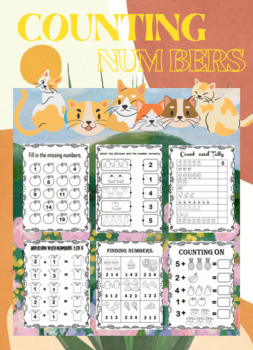Counting numbers
50 Downloads
Janjiminimal
2 Followers
Grade Levels
PreK - K
Subjects
Resource Type
Standards
CCSS1.NBT.A.1
NGSS1-ESS1-1
NGSSK-2-ETS1-1
NGSS1-LS3-1
NGSS1-PS4-1
Formats Included
- PDF
Pages
8 pages
Janjiminimal
2 Followers
Description
1. Counting on numbers
2. Addition with numbers 1 to 5
3. Match the pictures and the number correctly
4. Fill in the missing numbers
5. Finding numbers
6. Match the pictures and the number correctly
7. Count and Tally
8. Circle the number six.
Total Pages
8 pages
Answer Key
N/A
Teaching Duration
40 minutes
Last updated Sep 30th, 2021
Report this resource to TPT
Reported resources will be reviewed by our team. Report this resource to let us know if this resource violates TPT’s content guidelines.
Standards
to see state-specific standards (only available in the US).
CCSS1.NBT.A.1
Count to 120, starting at any number less than 120. In this range, read and write numerals and represent a number of objects with a written numeral.
NGSS1-ESS1-1
Use observations of the sun, moon, and stars to describe patterns that can be predicted. Examples of patterns could include that the sun and moon appear to rise in one part of the sky, move across the sky, and set; and stars other than our sun are visible at night but not during the day. Assessment of star patterns is limited to stars being seen at night and not during the day.
NGSSK-2-ETS1-1
Ask questions, make observations, and gather information about a situation people want to change to define a simple problem that can be solved through the development of a new or improved object or tool.
NGSS1-LS3-1
Make observations to construct an evidence-based account that young plants and animals are like, but not exactly like, their parents. Examples of patterns could include features plants or animals share. Examples of observations could include leaves from the same kind of plant are the same shape but can differ in size; and, a particular breed of dog looks like its parents but is not exactly the same. Assessment does not include inheritance or animals that undergo metamorphosis or hybrids.
NGSS1-PS4-1
Plan and conduct investigations to provide evidence that vibrating materials can make sound and that sound can make materials vibrate. Examples of vibrating materials that make sound could include tuning forks and plucking a stretched string. Examples of how sound can make matter vibrate could include holding a piece of paper near a speaker making sound and holding an object near a vibrating tuning fork.





